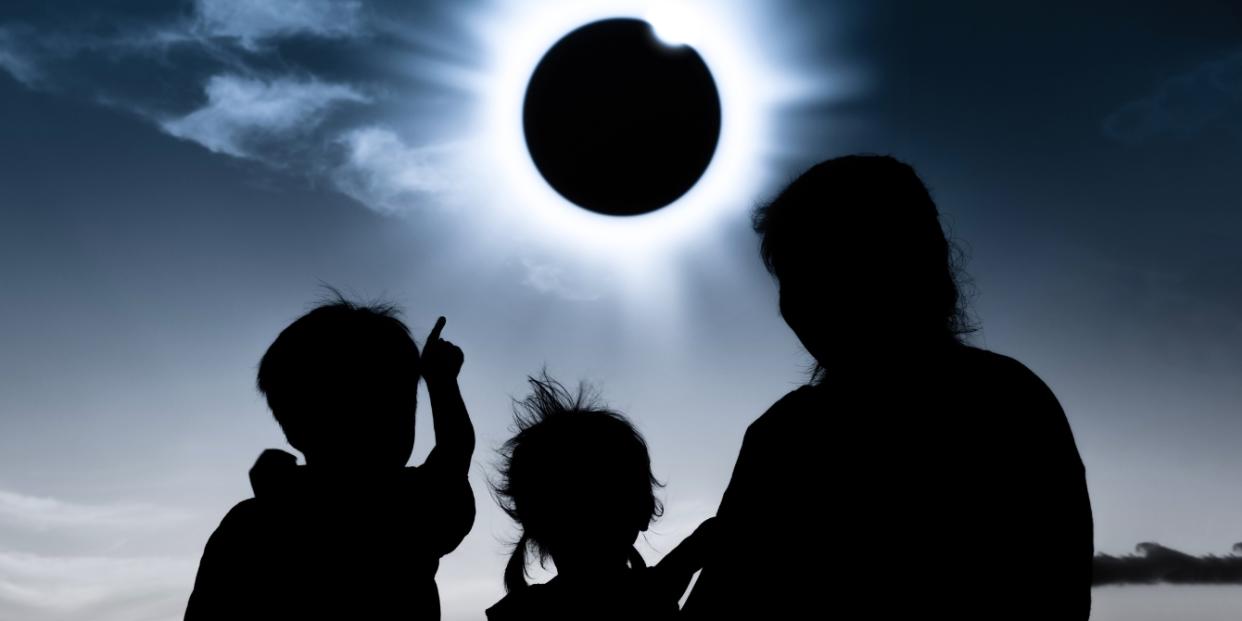Everything you need to know to plan your total solar eclipse watch party

The total solar eclipse of 2024 is gaining a lot of attention from avid space fans to amateur onlookers across the globe. If you’re in the path of totality then consider yourself lucky because you won’t have to contend with other travelers rapidly searching for accommodations.
It’s estimated that up to 4 million people will travel for this event. If you’re looking to plan a whole family getaway centered around the event or even if you just want to figure out how to watch the whole thing from your neck of the woods then, you’re in the right place. Scroll through for all you need to know to catch a glimpse of the solar eclipse.
When is the total solar eclipse
A total solar eclipse happens when the Moon comes between the Earth and the Sun, completely blocking the face of the Sun. The sky darkens and it can look like dusk in the middle of the afternoon—that darkness is what’s referred to as the path of totality.
On April 8, 2024 the total solar eclipse will be visible in parts of the US, Canada and Mexico. Although the phenomenon occurs every year, it’s not always visible from North America. The last time it occurred was in 2017 and, according to NASA, it won’t be visible again until 2044.
Which states are in the path of totality
It’s estimated that the path of totality will first hit Mexico at 11:07 am PDT (pacific daylight time). From there it will travel into Texas and make its way through a few lucky states. That’s not to say that you can view it from every corner of the state—some cities will have a better view than others. The duration of totality is typically just a few minutes long so planning your trip is key!
List of states in the path of totality:
Texas
Oklahoma
Arkansas
Missouri
Illinois
Kentucky
Indiana
Ohio
Pennsylvania
New York
Vermont
New Hampshire
Maine
If you’re interested in catching the different phases, partial visibility and totality, check out this time chart that outlines the exact times the eclipse will hit different cities.
How to catch a glimpse of the eclipse
Whether you’re an umbraphile who’s been waiting years and years for this day or you just want to see what all the fuss is about, there are different ways you can catch this spectacular event. Here are a few cities throwing a notable bash to mark the event:
1. French Village, Missouri
Solar Strings, the Missouri eclipse festival, runs April 5th to the 8th and is held in the beautiful Ozarks. It’s a family-friendly camping experience with live music and plenty of space to catch the total solar eclipse.
2. Burnet, Texas
The Texas eclipse festival will be held at Reveille Peak Ranch from April 5 to 9. You’ll be in the path of totality and you’ll also be immersed in science talks, interactive art, live music and so much more.
3. Hot Springs, Arkansas
Atlas Obscura’s Eclipse Festival is a four-day celebration, April 5 to 8, at the Valley of the Vapors. You’ll have a full viewing experience alongside live music. There’s also related events with astronomers, artists, philosophers and more.
4. Indianapolis, Indiana
The Indy Eclipse Weekend, April 5 to 8, brings special performances, films, lectures and gatherings all related to the scientific phenomenon. If that’s exciting enough, there’s also a food truck festival!
5. Burlington, Vermont
Burlington promises eclipse enthusiasts a small-town-meets-big-celebration experience. The weekend leading up to the big event is chock-full of eclipse activities including watch parties, artisan markets and festivals.
How to view the eclipse safely
Normally, looking directly at the sun can be damaging to our eyes, but on the day of the eclipse, when totality hits, there’s a brief period where you can do so. During the partial phases, you’ll need special solar-safe glasses.
Homemade glasses with dark filters, no matter how dark, are not enough to protect your eyes. The American Astronomical Society (AAS) has a special AAS Solar Eclipse Taskforce that already has a vetted list of manufacturers that produce safe products with which to view the eclipse safely. Unless you’ve got a telescope with a solar filter laying around somewhere, solar safe glasses are the way to go. (Need some suggestions? We’ve linked Taskforce-approved options below!)
The STAR library network, managed by the Space Science Institute, is offering free glasses, informational materials and eclipse-related activity ideas to libraries across the country. Check with your local library to see if they signed up!
Traveling the day of the eclipse
If you happen to be traveling that day, make sure to pack your solar safe glasses! Traveling by car, plane or boat—you’ll need specialty glasses in order to safely view the partial-eclipse. There are also specialty flights offered specifically for eclipse viewing and other regularly scheduled flights that could still offer a great view.
During totality, the skies darken and the temperature can drop a few degrees. If you’re planning on traveling to watch the solar eclipse 2024, don’t forget to bring a jacket!

